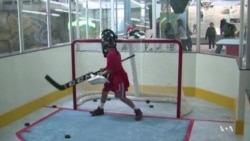Children learn about science from teachers, from TV and from museum visits. They can also learn about science from sports. Angles, friction, centrifugal force — understanding scientific principles can help win the game.
The ice hockey exhibit at the Discovery Cube science center in Los Angeles encourages young visitors to learn about the science of the sport through computer games and other activities. It is hosted by the city's professional hockey team, the Los Angeles Kings.
"We love the game of hockey. We played hockey growing up and we live it every day, so we get to share this with kids," said Kings President Luc Robitaille. The exhibit, he said, helps kids understand "how the ice is made, how to shoot a puck, how to be a goalie, what does it feel like to be a goalie, how does a Zamboni work — all those little things that you get to learn here. It's absolutely incredible."
Joe Adams, chief executive officer of the Discovery Science Foundation, said the exhibit is a good way to get into a difficult subject.
"Science is tough," he said. "It's a tough subject that kids have to learn in the classrooms. They have to study this stuff! This doesn't come natural, so we use the sports and all the champion players in the sport and the characters around it to be able to bring science to life, and that's exactly what's happening here today."
Young visitors seemed to agree.
"I enjoyed the ice and I learned that it was 26 degrees usually," said Gracy Riley. She also learned about "how fast you react with your hands with vibration and sound and light, and how fast pucks go on different surfaces."
Janglo Harbour called the exhibit "a lot of fun, and I really like how they did the blocking for the goalie and I like that you can learn how to shoot. It's really cool how you can block it and it will tell you if it's saved or a goal. It's like a video game you play in real life."
Visitors of all ages can explore the science of hockey at the Discovery Cube's newest exhibit.









